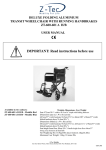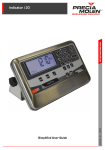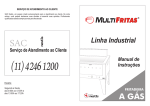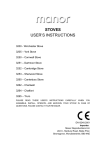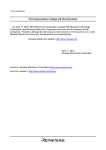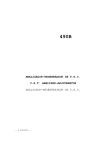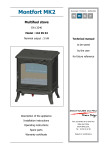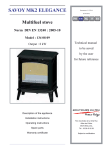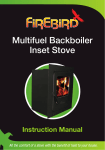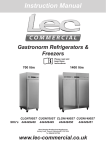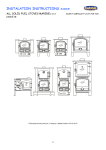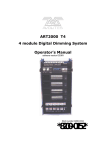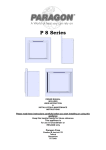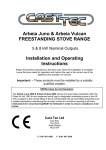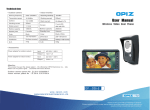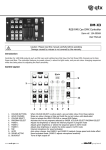Download Country Kiln Stoves User Manual in PDF
Transcript
TM STOVES USER’S INSTRUCTIONS Country Kiln 1,2, 3, 4, 5, 6, 7,8,9,10,11,12,14, 17, 21,22,23,24,25,26,27, 31,32,33,34,35,36,37,38, 41, 42. BSV-06, 07, 08, 410X, JA005, JA006, 701,702 PLEASE READ THIS USER’S INSTRUCTIONS CAREFULLY WHEN YOU ASSEMBLE, INSTALL, OPERATE, AND MAINTAIN YOUR COUNTRY KILN STOVES! DEALER STAMP EN13240:2001 TM STOVES The user’s instructions are suitable for Country Kiln models ranged from Country Kiln 1 to BSV702, total 34 models. Please see the following chart information, and select your models: Specification Nominal Recommended of cast iron Heat output fuels Kiln 1 grey iron 18# 5kW 67kg 620*155*185 (mm) Kiln 2 grey iron 18# 7.5kW Solid mineral fuels, peat briquettes, wood, multifuel Same above 86kg 560*410*480 (mm) Kiln 3 grey iron 18# 10kW Same above 120kg 570*460*690 (mm) Kiln 4 grey iron 18# 16kW Same above 168kg 740*560*710 (mm) Kiln 5 grey iron 18# 7.5kW Same above 88kg 570*420*480 (mm) Kiln 6 grey iron 18# 9kW Same above 116kg 570*390*670 (mm) Kiln 7 grey iron 18# 10kW Same above 110kg 620*490*560 (mm) Kiln 8 grey iron 18# 18kW Same above 198kg 710*560*850 (mm) Kiln 9 grey iron 18# 9kW Same above 95kg 610*420*580 (mm) Kiln 10 grey iron 18# 8kW Same above 88kg 580*480*440 (mm) Kiln 11 grey iron 18# 15kW Same above 129kg 660*510*750 (mm) Kiln12 grey iron 18# 15kW Same above 129kg 660*510*750 (mm) Models Weight Dimension (H*D*W) Specification Nominal Recommended of cast iron Heat output fuels Kiln 17 grey iron 18# 5kW 90kg 560*410*530 (mm) Kiln 21 grey iron 18# 6kW Solid mineral fuels, peat briquettes, wood, multifuel Same above 68kg 580*340*440 (mm) Kiln 22 grey iron 18# 8kW Same above 81kg 640*390*460 (mm) Kiln 23 grey iron 18# 8kW Same above 81kg 620*390*470 (mm) Kiln 24 grey iron 18# 8kW Same above 80kg 640*408*440 (mm) Kiln 25 grey iron 18# 7.5kW Same above 85kg 620*410*460 (mm) Kiln 26 grey iron 18# 7kW Same above 78kg 620*390*470 (mm) Kiln 31 grey iron 18# 5kW Same above 67kg 500*440*330 (mm) Kiln 32 grey iron 18# 7.5kW Same above 86kg 560*410*480 (mm) Kiln 33 grey iron 18# 10kW Same above 120kg 570*460*690 (mm) Kiln 34 grey iron 18# 16kW Same above 168kg 740*540*740 (mm) Kiln 35 grey iron 18# 7.5kW Same above 88kg 570*420*480 (mm) Kiln 36 grey iron 18# 9kW Same above 116kg 570*410*680 (mm) Kiln 37 grey iron 18# 10kW Same above 110kg 610*460*570 (mm) Kiln 38 grey iron 18# 18kW Same above 190kg 710*560*840 (mm) Kiln 41 grey iron 18# 15kW Same above 120kg 650*480*740 (mm) Kiln 42 grey iron 18# 15kW Same above 120kg 650*480*740 (mm) BSV-06 grey iron 18# 8kW Same above 92kg 540*430*470 (mm) BSV-07 grey iron 18# 5kW Same above 76kg 590*360*490 (mm) 410X grey iron 18# 11kW Same above 130kg 660*590*590 (mm) JA005 grey iron 18# 8kW Same above 90kg 620*420*580 (mm) JA006 grey iron 18# 12kW Same above 120kg 610*430*660 (mm) Kiln 701 grey iron 18# 5kW Same above 68kg 600*360*420 (mm) Kiln 702 grey iron 18# 8kw Same above 125kg 600*440*670 (mm) Models Weight Dimension (H*D*W) TM STOVES ASSEMBLY Please assemble your Country Kiln stoves according to the following instructions: → Country Kiln stoves come to you packaged in a plywood crate. in plywood crate ↓ → Remove the top crate and organise the parts. ↓ → Gently lower the stove on its back or prop back so that it rests with it`s back supported by the pallet at an angle. Unbolt the protective plywood panel from the bottom of the stove. ↓ TM STOVES → fix the legs with set screws and washers supplied. All screws and bolts should be hand tight torque only. ↓ → fit the baffle, retainer bar, and ashpan as shown. ↓ → Smear liberal amounts of fire cement round both exit holes. Fix the flue collar and blanking plate with screws and washers supplied. Hand tight torque. There are interchangeable rear and top flue options. It is essential that your stove is assembled correctly in order for your stove to burn efficiently. If you have any doubts, please contact ourselves on 01560483966 or email: [email protected] Warning! When assembling the appliance, care should be taken to avoid the possibility of personal injury. Any and all unauthorized modification of the appliance is strictly prohibited. Do not drag the stove in case you loosen the top or break the leg bolts. TM INSTALLATION STOVES It is important that all local regulations, including those referring to national and European Standards need to be complied with when installing the appliance. We are not responsible for any fault arising through incorrect installation, incorrect useage or incorrect firing. Safety Attentions Transfer Necessary facilities must be available for loading, unloading and site handling. Fire Cement Some types of fire cement are caustic and should not touch your skin. In case of contact, wash immediately with plenty of water. Metal Parts Be careful of personal injury when installing or maintaining this appliance. Other possible injuries The stove contains no harmful materials, but if there is a possibility of using any dangerous materials in the course of installation then please seek specialist guidance and use appropriate protective equipment. Important Warning! This appliance must not be installed into a chimney shared with any other heating appliance. There must not be an extractor fan fitted in the same room as the stove as this can cause an emission of fumes into the room. Chimney The chimney must be fitted in accordance with manufacturer’s instructions and Building Regulations. The chimney height and the position of the chimney terminal should conform to Building Regulations and all local regulations, including those referring to national and European Standards. The chimney must be in good condition, and any cracks and obstructions are not permitted. The diameter of the flue should not be less than 125mm and not more than 200mm. If any of these requirements are not met, the TM STOVES chimney should be lined by a suitable method. The chimney must be swept before connection to the stove. We also recommend that the chimney be swept a second time within a month of regular use after installation and a minimum of annually thereafter.Please consult your local chimney sweep, if you have any doubts about your chimney. Flue Draught A flue draught ranging from 1.2mm to 2.5mm water gauge may keep the appliance in good performance. If the flue draught exceeds 2.5mm, a draught stabilizer must be installed in order to control the rate of burning and prevent over fire. You should check the flue draught when fire is on high output. Chimney Connection You should brick up or seal an existing fireplace opening with a register plate. A short length of flue pipe of a minimum 125mm diameter may then be used to connect the stove to the chimney or lining appliances. This flue pipe should be of vitreous enamelled steel, nominal thickness 1.2mm. Ensure that the pipe end is no closer than 76mm to the side or rear chimney walls. Ideally there should be a smooth streamline entry into the flueway. The length of any horizontal run of flue pipe must not exceed 125mm. It is essential that all connections between the stove and chimney-flue are sealed and made airtight. Both the chimney and flue pipe must be accessible for cleaning and if ANY parts of the chimney cannot be reached through the stove(with baffle removed), a soot door must be fitted in a suitable position to enable this to be done. Air Supply A permanent, unobstructed, air opening is not essential for the room or space containing this appliance, although be guided by local regs which vary. The air opening should be at least 3625mm2 when a draught stabilizer is equipped. Due care for air requirements will need to be taken if any other appliances are permitted to work in the same room and space. Safety Clearances It is suitable for the appliance to be recessed in a prepared fireplace, but a suitable free air gap (minimum 150mm) must be left around the sides and top and at least 50mm at the back of the appliance to reach maximum heat output and for access to the rear of the stove. All non-combustible walls closer than 300mm to the stove should be at least 75mm thick. TM STOVES In all circumstances the back wall of the fireplace recess and the hearth should be made of non-combustible material, Allow an apron of a least 300mm at the front of the stove and 150mm on either side. The hearth on which the stove is to be placed should not be less than 125mm thick and should be in accordance with the current building regulations. Care should be taken to level the stove using the adjusting screws in the feet. The appliance should be installed on floors with an adequate load-bearing capacity. If an existing construction does not meet this prerequisite, suitable measures (e.g. load distributing plate) shall be taken to achieve it. There should be no combustible material within a distance of 500mm from any surface of the stove Commissioning and Handover You should leave an appropriate period of time for fire cement and mortar to dry out upon completion of the installation. In order to ensure the smoke and fumes are taken from the stove up the chimney and emitted safely to the atmosphere, a small fires should be lit first. Do not run the stove at full output for at least 72hours. Finishing installation and commissioning, the operating instructions and tools for your stoves should be kept in hand. It is also important to know how to use the stove properly and use only the recommended fuels for this appliance. The user should know how to have smoke or fumes emitted properly from the stove and be warned to prevent injuries in case of the presence of children, aged or infirm persons. Operating Instructions WARNING! All local regulations, including those referring to National and European Standards need to be complied with when installing the appliance.This appliance is not suitable for installation in a shared flue system.The firebox and ashpit cover shall be kept closed except during ignition, refueling and removal of residue material to prevent fume spillage. It is important to use this appliance correctly so as to achieve best results. TM STOVES Air Controls Warning! Parts of the appliance, especially the external surfaces, will be hot to touch when in operation and due care need to be taken, e.g. protective gloves should be worn when handling the stove while it is in operation. It is essential for the appliance to have a sufficient air supply for combustion and ventilation. Primary Air Primary air is controlled through the assembly on the bottom of the door. This provides a conventional air draught which passes through the fuel bed. The primary air intakes can be adjusted (opened or closed)to control the fire in the combustion chamber. Secondary Air This appliance is fitted with an air wash system which can assist to keep the heat-resistant glass on the fire door clean. This secondary air is controlled through the fittings on the top of the stove. The air controls have two types: one is rotary air controls; the other is sliding air controls. They are operated as follows: Bottom Grate: Two types of bottom grate are equipped with your Country Kiln stoves: rotary style or grid style. With the rotary style grate, you can operate it by dragging the stainless steel rod forward and backward to de-ash. With the grid style grate, a special hook is supplied to de-ash. It is highly recommended to de-ash regularly in case any build-up of ash damages the cast iron fuel bed. You should be careful of hot parts of a stove in operation. Ashpan: You should clean up the ashpan regularly as ash built up touchinh the base of the stove grate may cause damage. Use the supplied tool to pull the ashpan out of the stove. TM STOVES On solid mineral fuels Please keep no more than a 30℃ incline of the fuel bed from front to back, when you put solid mineral fuels on the fuel bed. The height of loading fuels must not exceed the rear cast iron lining. The refueling intervals at nominal heat output will be approximately 4 hours. We suggest you refuel regularly so as to get the best possible results. When using solid mineral fuels, we suggest you keep the secondary air control in the closed position, which can burn in maximum efficiency. At this time the primary air controls can adjust the burn rate of the appliance. In order to prevent the ash from being stacked against the underside of the bottom grate, please always flatten the ash or de-ash before refueling. Once the ash builds up, it can possibly stifle the airflow and cause the fire to die. Important!- It is very important to empty the ash pan regularly. If the ash builds up on the underside of the grate, burnout or distortion of the grate may be caused. On wood fuels The refueling intervals at nominal heat output will be approximately 1.5 hours. You may load wood higher in the stove than solid mineral fuel but wood or logs are not permitted to touch the baffle plate. Wood burns best with a layer of ash on the fuel bed with the multifuel grate removed. Care should be taken to only remove surplus residue from the stove when required. Care should be taken that logs for fuel are positioned cut end forward. We recommend you only use dry, seasoned wood as fuels; the wood should have been cut, split and stacked for at least one year in circulating air surround to dry out. Wet or unseasoned wood will cause tar deposits in the stove and unsatisfactory heat output will occur. Ignition, Seasoning and Running In It is better for you to have 2 or 3 small fires before operating your stove to its maximum heat output. This can help the paint to cure steadily and to give a long service life of the paint finish. During the period, there may be an unpleasant smell, you may keep all doors and windows open for your comfort although the smell is non-toxic. TM STOVES Firstly: load the stove with starting fuel, i.e. paper, dry sticks or firelighters. Secondly: light the fire at the base keeping the primary air controls open. Wait until the fuel reaches a steady glow, then build the fire up step by step, more fuel should be added when you have a nice fire settled across the grate or bed. Warning! You need to check for chimney blockage prior to re-lighting after a prolonged shut down period. Shutting Down Firstly, close the primary air controls. Secondly, close the secondary air controls. The fire should go out owing to lack of air. If reviving the fire, it is recommended to open the primary air controls first, then open the secondary air controls. Warning! The stove is still hot for some time after the fire has been extinguished. Fuels Fuels vary greatly in quality and performance. Sufficient air supply and above average fuel bed temperatures are required to maintain best performance for this appliance. You should only use authorized smokeless fuels in smoke control areas. Warning! The use of the appliance as an incinerator and the uses of liquid fire accelerants, petrol and unsuitable fuels are prohibited. (please note that Anthracite is used in the smelting process and improper use of Anthracite or Cite based superfuels can cause damage to the stove) If you are having any difficulties or problems regarding fuel, consult your local approved fuel merchant. TM STOVES Safety guidance FIRES CAN BE DANGEROUS-Do use a fireguard in the presence of children, the elderly or the infirm. The fireguard should be consistent with BS6539-Fireguards for use with solid fuel appliances. DO NOT OVERFIRE- over firing can be dangerous. If any part of the stove glows red, it shows that an over fire has occurred. This means the stove has been taken to a temperature beyond its design capacity. This is not permitted and can cause damage, you should keep an eye on how it is burning and adjust the controls accordingly. FUME EMISSION Emitted fumes can be avoided if the stove is installed and operated properly, fumes usually appear from the operations of de-ashing and refueling. Constant fumes must be assessed. If fume emissions do persist, then the following measures can be helpful: a) Put the fire out, or remove the fuel from the stove safely. b) Open doors and windows. c) Check the flue and chimney to prevent blockage and clean if required. d)Do not try to re-light the fire before the cause has been identified and corrected. e) If needed, please seek professional assistance. Warnings! –an extractor fan is prohibited in the same room as this appliance. Wind, weather and external conditions can alter the strength of a chimney draw. IN THE EVENT OF CHIMNEY FIRE. a. Close all the air controls and stove doors. b. Let others in the house know. c. Call the Fire Brigade. d. Move furniture and rugs away from the fireplace and remove any nearby ornaments. e. Place a fireguard in front of the stove. f. Feel the chimney for signs of excessive heat. If the wall is becoming hot, move the furniture away. Ensure that the Fire Brigade can have a command of your roof space in order to check the area for signs of spread. Regular chimney cleaning helps prevent chimney fire. TM MAINTENACE STOVES Stove body Use a soft brush to clean the stove, cleaning must be given only after cooling. The finish can be renewed with proprietary stove paint or stove black. Baffle plate Remove and clean the baffle plate once a month to avoid soot or fly ash blocking the flue ways and producing dangerous fume emission Fireproof glass Use a proprietary glass cleaner to clean the glass when cool. You can not use any materials which may bring glass damage to clean the panel. Wet logs on heated glass, a badly aimed poker or heavy slamming of the doors could crack the glass panels. You must be very careful. The glass is heat resistant but not reinforced. Stove rope Stove rope is supplied along with the stove. Inspect the rope around the door and glass. If the rope is becoming detached, use a proprietary stove rope glue to reattach it. Please replace the rope in case of poor condition. Flue way and Chimney Keep the chimney, flue way and any connecting flue pipe swept regularly. For users of smokeless fuels, sweep at east once a year; for wood and other fuels, at least twice a year. If the stove is fitted in place of an open fire, then the chimney should be swept one month after installation to clear any soot falls which may have occurred due to the difference in combustion between the stove and the open fire. Troubleshooting: If No Fire can be burnt Please check the following measures: A proper fuel is being used. The air inlet is unobstructed. Chimneys and flue ways are clear Sufficient air supply is into the room. No extractor fan is working in the same room as the stove. Fire blazing out of control Please Check: A suitable fuel is being used. The doors are tightly closed. The air controls are all in the closed position. The primary air control flap is not wedged in the open position. The glass retaining clips are not loose. The door rope seals are in good condition We suggest users buy replacement and spare parts only from ourselves. TM STOVES















